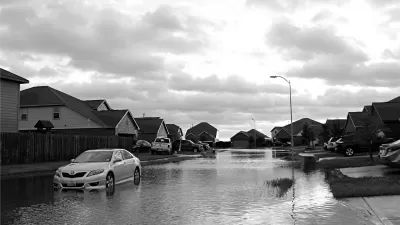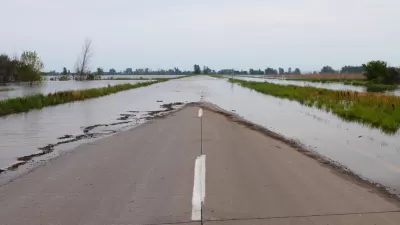Despite official calls following the 1993 floods along the Mississippi to remove development from flood plains, more housing and retail developments continue to be built along vulnerable areas.
"Once it was a cornfield; now it's a Wal-Mart, a Taco Bell, a Target. Here along a stretch of Missouri's Highway 40, in the Chesterfield Valley area just west of downtown St. Louis, what's said to be the largest strip mall in the country sits on about 46 acres of Mississippi River bottomlands. Less than 20 years ago, the land was open space.
It's been fifteen years since the Great Flood of 1993 put this land under 10 feet of water. Since then, thousands of acres of floodplain in the St. Louis area have been built up with strip malls, office and industrial parks, and 28,000 new homes. And all this infrastructure depends on miles and miles of levees to hold back the Mississippi and Missouri rivers the next time they try to retake the land.
If you ignore the historical tendency of the Mississippi and Missouri to periodically drown it, this vast, flat landscape does present an appealing canvas for building.
The Flood of 1993 was one of the most destructive in the recorded history of the Mississippi Basin: nearly 50 people were killed, over 70,000 evacuated, and 50,000 homes damaged on over 17 million acres (close to 27,000 square miles) across nine states. Over 16,000 square miles of working cropland was flooded, at a loss of more than $5 billion. All told, the flood caused around $16 billion in damage.
But official resolve to depopulate the floodplain has given way to development fever in Missouri: over $2.2 billion worth so far on land that was underwater in 1993. And unlike some of the other states deluged in the Flood of 1993, such as Wisconsin, Iowa, and Illinois, Missouri has been much slower to enact stronger regulations for floodplain development -- perhaps because the state has hundreds of miles of floodplain fronting the Mississippi and Missouri rivers (read: lots of tax income lost and jobs unrealized if new businesses and homes don't get built)."
FULL STORY: Tempting Fate: Why We Insist on Living in Floodplains

Maui's Vacation Rental Debate Turns Ugly
Verbal attacks, misinformation campaigns and fistfights plague a high-stakes debate to convert thousands of vacation rentals into long-term housing.

Planetizen Federal Action Tracker
A weekly monitor of how Trump’s orders and actions are impacting planners and planning in America.

Chicago’s Ghost Rails
Just beneath the surface of the modern city lie the remnants of its expansive early 20th-century streetcar system.

Bend, Oregon Zoning Reforms Prioritize Small-Scale Housing
The city altered its zoning code to allow multi-family housing and eliminated parking mandates citywide.

Amtrak Cutting Jobs, Funding to High-Speed Rail
The agency plans to cut 10 percent of its workforce and has confirmed it will not fund new high-speed rail projects.

LA Denies Basic Services to Unhoused Residents
The city has repeatedly failed to respond to requests for trash pickup at encampment sites, and eliminated a program that provided mobile showers and toilets.
Urban Design for Planners 1: Software Tools
This six-course series explores essential urban design concepts using open source software and equips planners with the tools they need to participate fully in the urban design process.
Planning for Universal Design
Learn the tools for implementing Universal Design in planning regulations.
planning NEXT
Appalachian Highlands Housing Partners
Mpact (founded as Rail~Volution)
City of Camden Redevelopment Agency
City of Astoria
City of Portland
City of Laramie





























